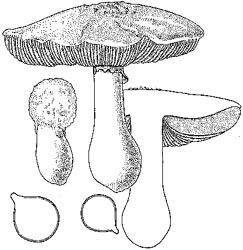|
[ Section Lepidella page. ]
[ Amanita Studies home. ]
[ Keys & Checklist/Picturebooks ] "Playing Field Lepidella"
Technical description (t.b.d.) BRIEF DESCRIPTION: The cap of A. praeclara is 50 - 160 mm wide, thick-fleshed, globose to plano-convex, sometimes slightly depressed at the center, white, staining pale yellow, appendiculate, with a nonsulcate margin. The cap is minutely felted-fibrillose to fibrillose-squamulose, with white, lanose-floccose covering when young, with age glabrescent or with some poorly delimited, felted to subverrucose patches over the center. The gills are crowded to subdistant, adnexed to free, thin, rather broad, straight or ventricose, white to cream, and staining pale yellow. The stem is 70 - 130 x 1 - 20 mm, equal, solid, firm, white, and glabrous. The spores measure 8 - 9.5 (-10) x 8 - 9 (-10) Ám and are amyloid and globose. Clamps are not found at bases of basidia. Amanita praeclara was originally described in the genus Lepiota from Cape Province, South Africa where it occurs in fields and lawns -- apparently without a woody plant symbiont. Bas placed A. praeclara in his stirps Thiersii. See A. thiersii Bas for discussion of the species now included in this stirps. -- R. E. Tulloss Drawing: Dr. Cornelis Bas (1969) (reproduced by courtesy of Persoonia, Leiden, the Netherlands)
[ Section Lepidella page. ]
[ Amanita Studies home. ]
[ Keys & Checklist/Picturebooks ] Last changed 19 July 2008. |
